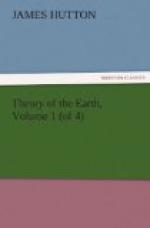Therefore, altho’ it is unquestionable that the strata in the alpine and low countries had the same or a similar original, yet, as the vertical position, which is the greatest possible change in that respect, is more natural to the alpine strata, or only necessary in the natural order of those bodies, we are to consider this great disorder or change from the natural state of their original formation, as the proper character of those alpine strata. But then it is also necessary to include in this character a general hardness and solidity in those vertical strata, otherwise they would not have been properly alpine, or have resisted the wearing and washing powers of the globe, so as to have remained higher than the others; for, the vertical position, or great inclination of those strata, should rather have disposed them the more to dissolution and decay. Let us now see how far we shall be justified in that general conclusion, by the examination of those bodies.
The fact is certain, that those alpine bodies are much harder, or less subject to dissolution and decay, than the horizontal strata. But this must be taken in the general, and will by no means apply to particular cases which might be compared. Nothing, for example, more solid than the lime-stones, or marbles, and iron-stones; nothing more hard or solid than the chirt or flint; and all these are found among the horizontal strata. But, while some strata among those horizontal beds are thus perfectly solid, others are found with so slight degrees of consolidation, that we should not be able to ascribe it to the proper cause, without that gradation of the effect, which leads us to impute the slightest degree of consolidation to the same operations that have produced the complete solidity. While, therefore, the most perfect solidity is found in certain strata, or occasionally among the horizontal bodies, this forms no part of their character in general, or cannot be considered as a distinctive mark, as it truly is with regard to the alpine strata. These last have a general character of consolidation and indissolubility, which is in a manner universal. We are, therefore, now to inquire into the cause of this distinction, and to form some hypothesis that may be tried by the actual state of things, in being compared with natural appearances.
As the general cause of consolidation among mineral bodies, formed originally of loose materials, has been found to consist in certain degrees of fusion or cementation of those materials by means of heat; and as, in the examination of the horizontal strata we actually find very different degrees of consolidation in the several strata, independent of their positions in relation to height or depth, we have reason to believe that the heat, or consolidating operation, has not been equally employed in relation to them all.




